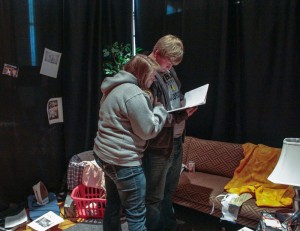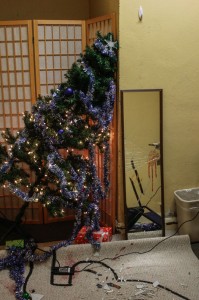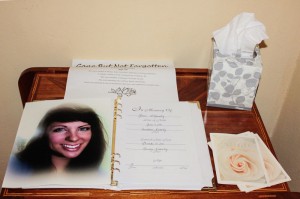The Women’s Center hosted Crazy In Love, a hands-on exhibit about domestic violence on college campuses. The program was meant to make students and faculty aware of the warning signs of domestic violence.

A couple reads journal entries written by a fictitious domestic violence victim in the exhibit.
“The exhibit is helpful to those involved in domestic abuse, as well as loved ones who may be involved,” said Kendall Swinney, graduate student from Murray. “It lets people see the different types of abuse, as well as how to determine if a relationship is unhealthy. It can be hard to realize that a relationship is unhealthy until you are aware of the warning signs.”
The exhibit was free of charge and open to all students and faculty on campus from Monday through Thursday in Wrather Museum. The Women’s Center also encouraged and invited volunteers to help guide and answer the questions of those who visited.
“I wanted to volunteer for something that would help me if I ever needed it,” said Quiana Mayes, sophomore from Murray. “Being a woman, the exhibit showed me the warning signs of an unhealthy relationship so that I am better prepared if I ever experience a similar situation.”

A note on a magazine can be a warning sign.
The walk-through exhibit included journal entries of a fictional couple it was showcasing, as well as video clips and other visual aids such as notes left around a house and day-to-day to-do lists. Separated into four rooms, an entire relationship over the course of less than a year was depicted. Each room represented different stages of what is known as the battering cycle.
According to the Women’s Center, the battering cycle includes the honeymoon stage, the tension building stage and the acute explosion stage.
Room one of the exhibit introduced the new relationship, the honeymoon stage, as something beneficial to both parties involved. The journal entries written by Jenna, the female involved, were full of excitement. Her to-do lists were full of dates with Chris, the boyfriend, group outings with friends and study time for exams. Usually, the honeymoon stage is full of presents, praise and the belief that nothing could go wrong.

Room Four, a scene depicting violence was part of the display.
In rooms two and three, Jenna’s stress level increases and plans begin to disappear. Journal entries were filled with negative words while self-doubt filled her mind. The exhibit showed that the tension building stage develops when stress overwhelms the relationship. Arguments and fights replaced sweet messages and caring words. Tension between the couple involved putting the other person down and making them feel as if they were the cause of the struggling relationship.
Room four, the final room, showed Jenna realizing she was in an abusive relationship and is ready to get herself out. Restraints against Chris were acquired, but for someone as abusive as he was, Chris didn’t accept Jenna leaving him. Ultimately, actions were taken too late and it led to her unfortunate death. Acute explosion, showcased in room four, is the stage when the abuser accepts that they are out of control and releases rage through hitting, yelling, humiliation and sometimes the use of weapons on the victim. The stage doesn’t end until the abuser believes the victim has learned his or her lesson, which could sometimes mean death.
“The Women’s Center held Crazy In Love to open eyes to similar situations,” said Stephanie Smith, senior and Women’s Center worker from Murray. “Domestic violence isn’t talked about often.”

Through visual aids visitors to the exhibit learned the tragic ending of a fictitious abuse victim’s story.
The interactive and realistic exhibit, Crazy In Love, brings attention to signs that could save a loved one’s life. Warning signs include pushes, slaps, forceful restraints, breaking of furniture or any other physical action that could cause pain to a person or destruction of property. Emotional warning signs include the ignoring of feelings, withholding of affection, humiliation, manipulation and restriction of social life with friends or family.
“Relationships are over-hyped these days,” Smith said. “They move fast. They tend to start off normal and the people involved are crazy in love. They ignore that people can change and don’t see the signs or refuse to see them. It’s a real issue that needs to be addressed. The exhibit was designed to be a conversation starter of sorts.”
Story by Katrina Yarbrough, Contributing Writer